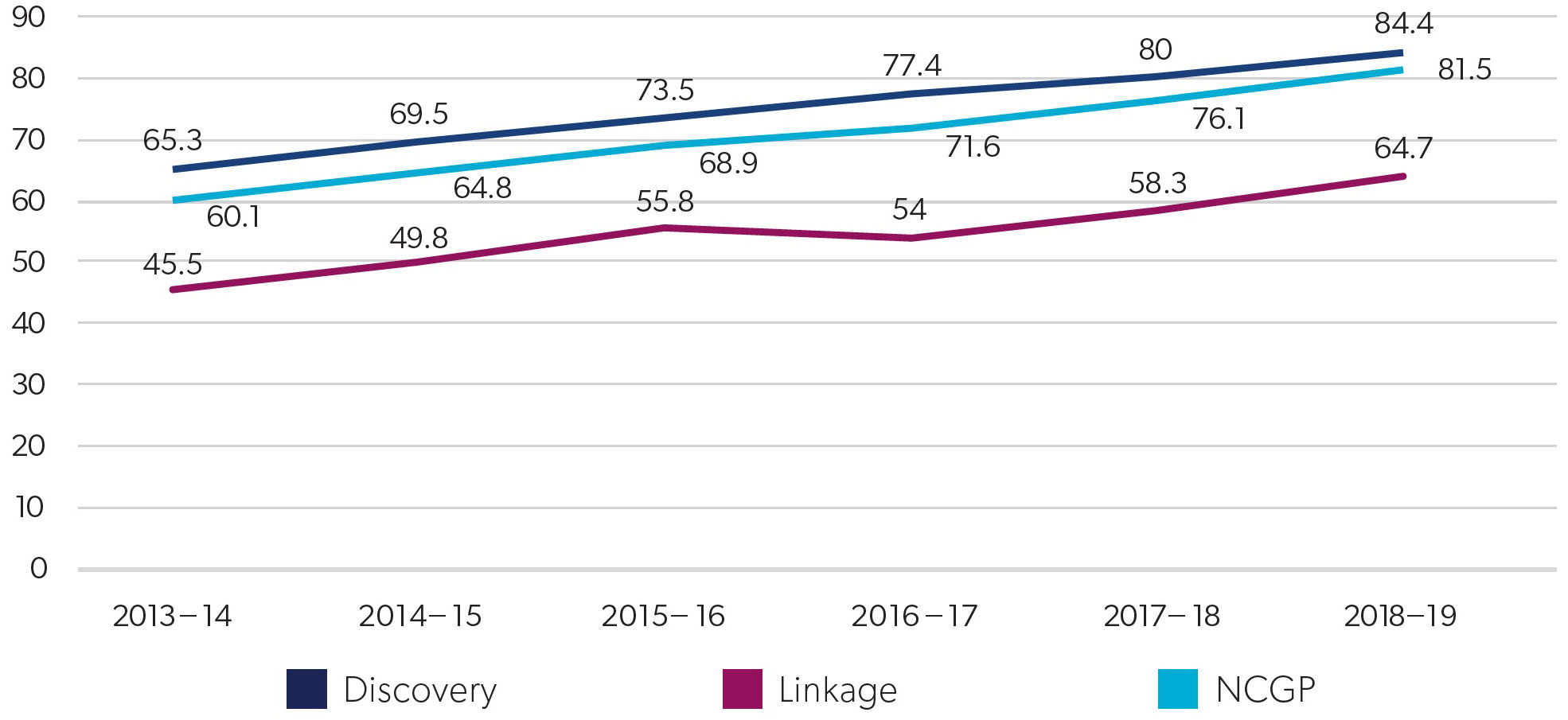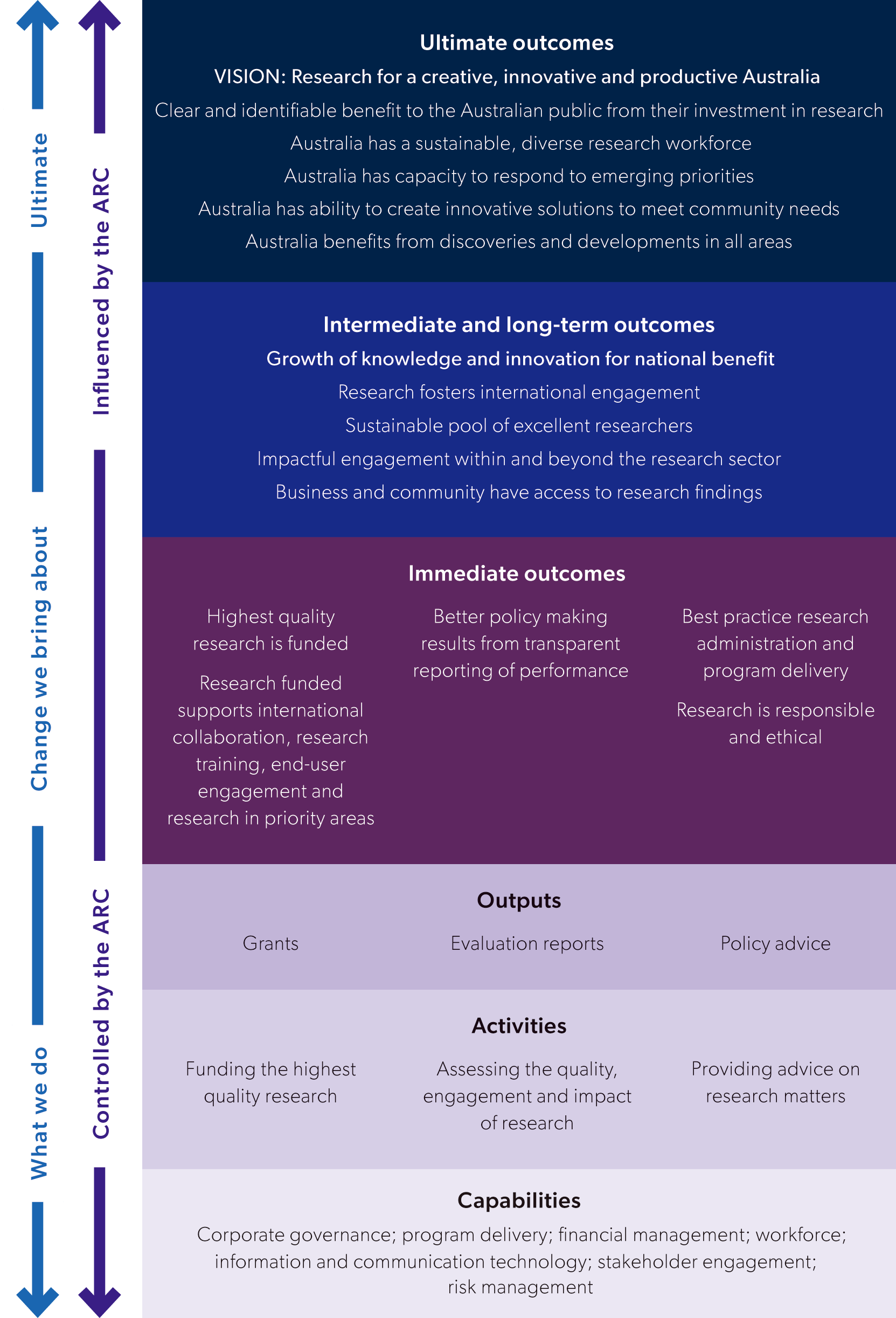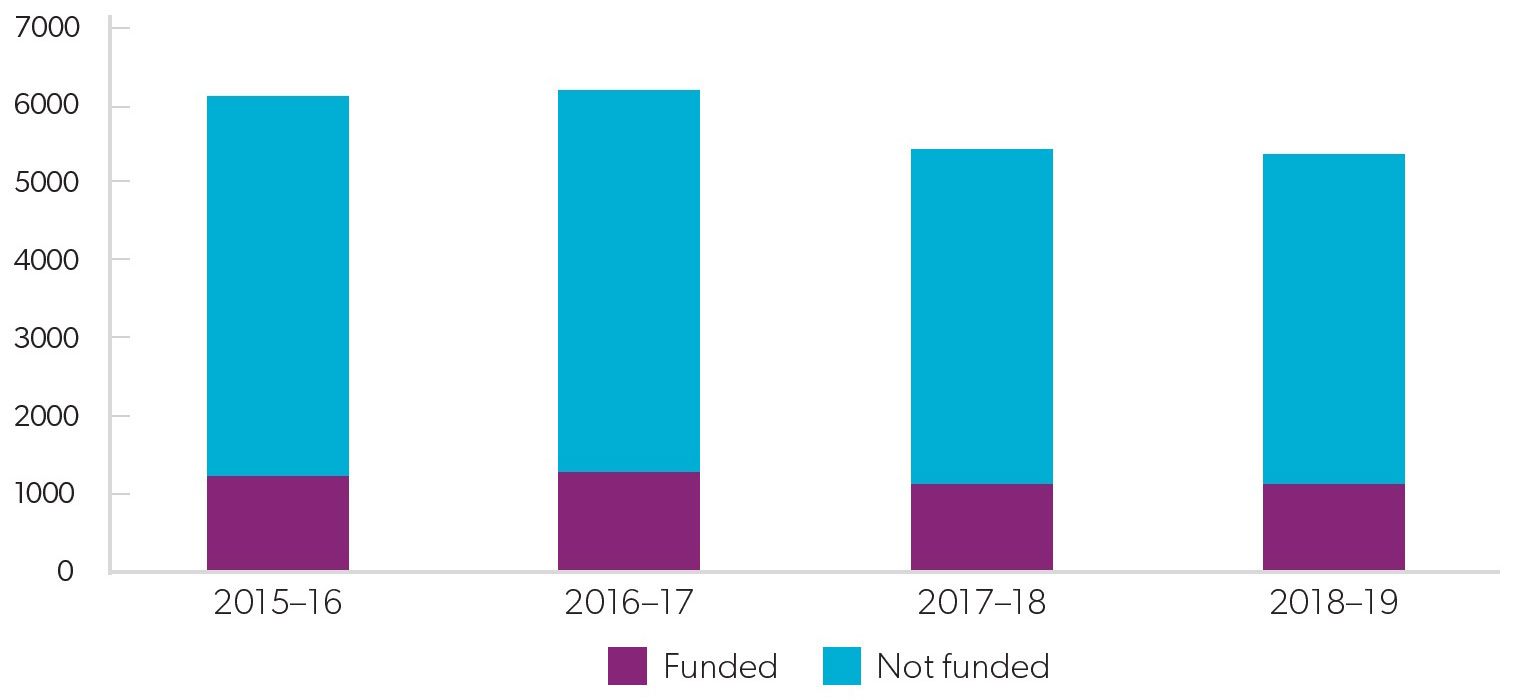Key indicators of the NCGP's success in meeting ARC Corporate Plan 2018–19 (page 14) objectives relate to:
- the sustainability of Australia's research workforce
- improved engagement between universities, industry and other research sectors
- support received from the university sector
- improved international engagement
- the extent to which research projects address Australian Government research
priorities
- providing economic, environmental, social, health and/or cultural benefits to
Australia.
Explanatory notes
-
Some measures relate to matters which are
outside the ARC's influence,
potentially impacting the agency's ability
to achieve the targets
identified. For instance, economic
conditions may impact both the
capacity of partner organisations to
financially contribute to research
projects, as well as the realisation of
research benefits.
-
Measuring performance against a target of
maintaining or increasing
certain performance levels is done in the
context of multiple year
trends rather than single year results.
-
Figures used in Section 3.1 to assess
performance outcomes reflect data
collected on the basis of grants awarded,
and do not directly correspond
to financial statement information provided
elsewhere in this report.
Data notes
- Unless otherwise stated, data for the
Discovery and Linkage Programs for
2018–19 relate to new funding from the
following scheme rounds:
-
Discovery Program:
Australian Laureate
Fellowships (2018), DECRA (2019),
Discovery Indigenous (2019),
Discovery Projects (2019) and Future
Fellowships (2018)
-
Linkage Program:
ITRH (2019), LIEF (2019),
Linkage Projects (2017, 2018) and
Supporting Responses to
Commonwealth Science Council
Priorities (2017).
-
Data and information are drawn from final
reports that have been
submitted to the ARC for research projects
commencing in 2013 (noting
that most ARC projects involve multi-year
funding).
-
Key Activity 1 performance measurement data
identified as incorporating
'new and ongoing' funding includes all
projects that received funding in
2018–19 (that is, projects commencing
in 2018–19 as well as
projects that commenced in a previous year
and continued to receive
funding in 2018–19).
Extent to which ARC-funded research supports the sustainability of Australia's research
workforce
Why is this important?
Research performance is critically dependent on access to highly qualified and skilled personnel. The ARC's aim is to foster research training and career development opportunities through its funding schemes, including opportunities under its Linkage Program for researchers to spend time in industry organisations.
Analysis of results
In 2018–19 16.4 per cent of Discovery Program funding (new and ongoing) was allocated to the DECRA scheme and 10.4 per cent of Linkage Program funding (new and ongoing) was allocated to the ITTC scheme.
The proportion of DECRA funding allocated under the Discovery Program has gradually increased over the past four reporting periods. The ARC has a range of mechanisms to support early career researchers. The agency's Research Opportunity and Performance Evidence (ROPE) assessment criterion ensures that the research output of funding applicants is assessed within the context of their career stage. In 2018–19 the ARC also released the Early Career Researchers Statement of Support, which outlines the strategies used by the ARC to provide opportunities to early career researchers, both within the DECRA scheme and the NCGP more broadly.
The proportion of ITTC scheme funding allocated under the Linkage Program has also increased over time. The ITTC scheme, funded as part of the Industrial Transformation Research Program (ITRP), fosters opportunities for Higher Degree by Research candidates and postdoctoral fellows to pursue training in industrial priority areas identified by the ARC. These priorities reflect the six high-growth sectors established under the Industry Growth Centres Initiative. The ARC conducted a range of outreach and engagement activities with research and innovation sector stakeholders to support applications for the ITRP in 2018–19.
The more consistent results for the DECRA scheme may reflect the nature of the support provided, as the maximum number of fellowships that may be awarded is set, subject to the quality of applications. Under the ITTC scheme, alternatively, the number of projects funded are dependent on the total funding available, the number of applications received and the quality of those applications.
Additional context
In 2018–19 the ARC:
-
provided direct salary support for 320 new awards and fellowships encompassing every
research career stage, from early career researchers to senior researchers
-
funded 1155 new projects, involving 2464 researchers across the NCGP. This funding
support enabled the employment of additional research personnel and contributed
significantly to the development of Australia's research capacity.
Extent to which ARC-funded research results in improved engagement between universities,
industry and other research sectors
Why is this important?
Research is a collaborative activity with successful researchers and research organisations working together, partnering and networking to generate multiplier effects. The ARC's aim in supporting engagement between universities and other sectors is to maximise opportunities to build the scale and focus of research involving end-users, resulting in direct benefits to Australia.
Analysis of results
Under the Linkage Projects scheme, the combined cash and in-kind contributions pledged by partner organisations are required to match, at least, the funding sought from the ARC. In 2018–19 this requirement was exceeded with every ARC dollar attracting $1.91 from partner organisations. This outcome reflects a slight increase when compared to partner organisation contributions provided in the previous financial year.
A partner organisation's commitment of funding and other resources to a research project indicates an expectation of gain from that investment. Analysis of partner organisation feedback conducted for this Annual Report showed that a majority of partners that provided feedback on final reports (96 per cent) found that the collaborative research project had been either 'very beneficial' or 'beneficial' to their organisation. The feedback also showed that:
- 39 per cent of partner organisations were entering into a new collaborative
relationship and 60 per cent were building on a previously established relationship
(one per cent selected 'other')
- 93 per cent indicated that they would be willing to conduct a collaborative research
project again, depending on the circumstances.
In 2016 the ARC introduced a continuous application process for the Linkage Projects scheme. This was announced as part of the Australian Government's 2015 National Innovation and Science Agenda initiative, aimed to shorten the duration of the assessment process. One hundred per cent of applications received under the relevant selection rounds for the Linkage Projects scheme had recommendations made to the Minister within six months of submission in 2018–19.
Additional context
The Linkage Program comprises a range of schemes aimed at building collaborative research partnerships between researchers in universities and other organisations. These schemes are targeted at different elements of end-user engagement:
- the Linkage Projects scheme aims to support innovation at all levels,
involving end-users from government, not-for-profit organisations and both domestic
and international industry
- the ITRP aims to support the development of solutions for industry, and train future
researchers, through partnerships between universities and industry in identified
industrial transformation priority areas
- the ARC CoE scheme aims to build linkages across all sectors including a strong
international focus
- the LIEF scheme aims to support collaborative use of infrastructure, primarily
between universities, but also involving partner organisations from outside the
sector where appropriate.
Extent to which ARC-funded research results in improved international engagement
Why is this important?
Research is a global activity with researchers seeking access to the best partners and facilities worldwide. The ARC's aim in supporting international research collaboration is to maximise Australia's contribution to, and benefits from, international research collaborations, partnerships, developments and policy.
Analysis of results
The proportion of ARC-funded research projects involving international collaboration has increased over the past four years (Figure 6).
The ARC's mechanisms of support for international collaboration have not changed significantly over this period, indicating that the general upward trend of results for the Discovery and Linkage Programs represents a real change in levels of collaboration.

Additional context
In supporting international collaboration, the ARC seeks to build the capacity of Australia's research workforce by facilitating engagement with outstanding researchers overseas, as well as drawing on best practice and research developments internationally. These opportunities strengthen Australia's research capacity, and maintain and expand upon Australia's position as a world leader in research.
NCGP funding schemes use a variety of mechanisms to support international research collaboration, including:
- all NCGP schemes are open to overseas researchers as long as they apply through an
Australian eligible organisation. If successful, Chief Investigators, fellows and
awardees must reside predominantly in Australia for the duration of the project
- as appropriate, researchers located overseas may participate in ARC-funded projects
as Partner Investigators without any residency requirements
- project funding can be requested to support international travel by Chief
Investigators, fellows, awardees and Partner Investigators associated with a
project, to foster and strengthen collaborations between researchers in Australia
and overseas
- organisations based overseas (including higher education, companies, not-for-profit
and government) are eligible to participate in projects funded under the NCGP, as a
partner, host or 'other' organisation
- international subscriptions are an eligible budget item under the LIEF scheme.
In relation to projects awarded funding commencing in 2018–19:
- 2175 instances of potential international collaboration were identified with more
than 85 countries. The five countries most commonly identified were the United
States of America, the United Kingdom, Germany, China and Canada
- 721 cases of international participating organisations (comprising 466 unique
international organisations) were identified (including host and 'other'
organisations under the Discovery Program, and partner and 'other' organisations
under the Linkage Program)
- 130 cases of international partner organisations (comprising 126 unique
international partner organisations) were identified on projects awarded funding
under the Linkage Projects scheme
- the top five fields of international collaboration were: pure mathematics;
astronomical and space sciences; materials engineering; atomic, molecular, nuclear,
particle and plasma physics; and genetics
- international subscriptions were funded under the LIEF scheme
project—Enabling the future of the Australian collider physics
program.
Extent to which ARC-funded research addresses areas of Australian Government priority
Why is this important?
Through the identification of priority areas, the Australian Government aims to focus research on areas that address challenges facing Australia. The ARC contributes to this aim by funding research in priority areas under the NCGP.
Analysis of results
Approximately 60.7 per cent of projects awarded funding commencing in 2018–19 involved research relevant to the Australian Government's Science and Research Priority areas. This figure is consistent with the outcome achieved in 2017–18.
The result recorded for the Discovery Program is lower than the result recorded for the Linkage Program, reflecting the different objectives of the two programs. The Discovery Program is aimed at supporting fundamental research, while the Linkage Program has a greater focus on supporting research partnerships between universities and organisations that will result in the applied use of research.
Additional context
The Australian Government announced the National Science and Research Priority areas in May 2015. The nine cross-disciplinary priorities are food, soil and water, transport, cybersecurity, energy, resources, advanced manufacturing, environmental change and health. These are supported by 30 Practical Research Challenges at the Practical Research Challenge level.
In applying for NCGP funding, researchers are asked to indicate if their project falls within a priority area. While funding is not specifically directed to these areas, most schemes ask assessors to consider whether the research will address or has the potential to address these areas. The ARC engaged with stakeholders to review its implementation of the National Science and Research Priorities within the NCGP throughout 2018–19.
In addition to the National Science and Research Priority areas, in 2018–19 the ARC:
- administered a Special Research Initiatives scheme to support the
development of innovative technologies to investigate and remediate PFAS
contaminated areas, including soil and other solid contaminated debris, groundwater,
waterways and marine systems. Funding from the first round of the PFAS Remediation
Research Program was announced, and the selection process for the second round
commenced, within this reporting period
- began the selection process for Excellence in Antarctic Science, which is funded
under the ARC's SRI scheme. This program was developed as part of the Australian
Government's response to the Australian Antarctic Strategy and 20 Year Action
Plan. It will fund research examining the strategic, economic, scientific
and environmental significance of Antarctica to Australia, as well as fostering
collaboration between Australian researchers, industry and international
stakeholders
- continued to support Industrial Transformation Priorities under the ITRP. The
priorities for funding commencing in 2018 were advanced manufacturing, cyber
security, food and agribusiness, medical technologies and pharmaceuticals, mining
equipment, technology and services, and oil, gas and energy resources. These
priorities are consistent with the six high-growth sectors established under the
Australian Government's Industry Growth Centres initiative.
Extent to which ARC-funded research results in outcomes of benefit to Australia
Why is this important?
In a tight fiscal government environment it is important that the positive outcomes of the Australian Government's investment in research can be clearly demonstrated. ARC-funded research provides economic, environmental, social, health and cultural benefits to Australia.
Analysis of results
The ARC delivers a broad and diverse range of benefits to the Australian community through research funded under the NCGP. These include economic benefits through opportunities for commercialisation, the promotion of environmental sustainability and ecological responsibility, improvements to social well-being, support for positive health outcomes, and enhanced cultural and historical awareness. While the full scope of the impacts delivered through ARC-funded research is difficult to quantify, case study methodologies can usefully exemplify the positive outcomes delivered through NCGP funding.
In July 2019 the ARC released the Making a difference—Outcomes of ARC supported research 2018–19 booklet, an annual publication that demonstrates the economic, environmental, social, health and cultural benefits arising from a sample of the research supported under the NCGP. Various case studies from this publication have been used to exemplify some of the benefits stemming from ARC-funded research (see pages 46–51). Making a difference can be accessed via the ARC website, www.arc.gov.au > News > Publications > Making a difference. Case studies from the Making a difference booklet are drawn from the ARC's Research Highlights stories, which are published regularly on the ARC's website and social media, www.arc.gov.au > News > Media > Research Highlights.
Performance summary
There were no changes in the ARC's activities, organisational capability or environment that impacted significantly on its performance in delivering Key Activity 1: Funding the highest quality research.
As indicated on page 23, during the year the ARC:
- announced funding for the first round of the SRI: PFAS initiative, and commenced the
selection process for the second round of funding
- sought applications for the SRI: Excellence in Antarctic Science.
The ARC also continued to build upon its program of stakeholder engagement, particularly with the larger scale funding schemes, including the ARC CoE scheme and the ITRP. The focus was on improved grants management by grantees and the promotion of high quality applications for major awards, with applications typically commencing many months before the scheme opens.



